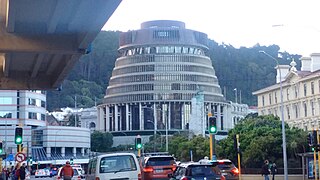
Wellington City Council is a territorial authority in New Zealand, governing the city of Wellington, the country's capital city and third-largest city by population, behind Auckland and Christchurch. It consists of the central historic town and certain additional areas within the Wellington metropolitan area, extending as far north as Linden and covering rural areas such as Mākara and Ohariu. The city adjoins Porirua in the north and Hutt City in the north-east. It is one of nine territorial authorities in the Wellington Region.

Lambton Quay is the heart of the central business district of Wellington, the capital city of New Zealand.

Te Aro is an inner-city suburb of Wellington, New Zealand. It comprises the southern part of the central business district including the majority of the city's entertainment district and covers the mostly flat area of city between The Terrace and Cambridge Terrace at the base of Mount Victoria.

Wellington railway station, or Wellington Central station, is the main railway station serving Wellington, New Zealand, and is the southern terminus of the North Island Main Trunk, Wairarapa Line and Johnsonville Line.

Frank Kitts Park is a public park situated between Jervois Quay and the Lambton Harbour waterfront in Wellington, New Zealand. It is named after Sir Frank Kitts, New Zealand politician and mayor of Wellington.

The T & G Mutual Life Assurance Society was an insurance company that operated in Australia and New Zealand. The 'T & G' stood for 'Temperance & General'. The company was founded in Victoria in 1876, emerging from the Assurance branch of the Independent Order of Rechabites with 132 policies. The branch was severed from the I.O.R. after six years of operations.

Kirkcaldie & Stains was a mid-sized department store in Wellington, New Zealand. It was established in 1863 by John Kirkcaldie and Robert Stains with a capital of £700. The first store was opened on Lambton Quay. In 1868 Kirkcaldie & Stains moved to their final location at the corner of Lambton Quay and Brandon Street, expanding several times. There was a branch in Napier from 1897 until 1917, and a branch on Cuba Street, Wellington for seven years (1871–76). French luxury skincare brand Sisley was exclusive to the store in New Zealand.

The reclamation of Wellington Harbour started in the 1850s, in order to increase the amount of usable land for the then new City of Wellington. Land plots in the early city were scarce, with little room for public buildings and parks, as well as inadequate dockside areas for shipping. Reclamation progressively advanced into the harbour throughout the 19th and 20th centuries, providing room for public, commercial and industrial areas for the city. Large reclamations were made in the 1960s and '70s to meet the demands of container shipping and new cargo handling methods.

The Old Bank Arcade is a retail and office complex on a corner site at Lambton Quay, Wellington, New Zealand.

Stewart Dawson's building was a historic building on the corner of Lambton Quay and Willis Street in Wellington, New Zealand. The façade has been retained. Built in 1900 for the London jeweller David Stewart Dawson, it was located on a prominent corner where major thoroughfares Lambton Quay and Willis St meet. The site, commonly known as 'Stewart Dawson's corner', is particularly important to the history of Wellington.

Wellington Central is an inner-city suburb of Wellington, and the financial heart of both the city and the Wellington Region. It comprises the northern part of the central business district, with the majority of Wellington's high-rise buildings.

Bowen House is a 22-storey office building on the corner of Lambton Quay and Bowen Street, Wellington, New Zealand, that is leased by the New Zealand Parliament to house some members of Parliament and government staff.

Wellington Harbour Board was the body which formerly managed the shipping and commercial affairs of the port of Wellington in New Zealand. It was constituted in 1880 and was disestablished in 1989.

Plimmer Towers is a high-rise office, hotel and car park complex in central Wellington, New Zealand, named after John Plimmer, active in business and politics during Wellington's early years. The office building is 84m high and has 31 storeys. It was the tallest building in New Zealand until Auckland's Quay Tower opened in 1981.

Whitmore Street is at the boundary of the central business district and the government buildings area of Wellington, New Zealand's capital. The street runs almost north-south and is one of those linking Lambton Quay, Wellington's main shopping street, with Stout Street, Featherston Street and the harbourside at Customhouse/ Waterloo Quay. It is in the suburb of Pipitea.

BNZ Harbour Quays was a large office building on the waterfront in Wellington, New Zealand. It was built in 2009 and leased to the Bank of New Zealand, but suffered earthquake damage in the 2013 Seddon earthquake and the 2016 Kaikōura earthquake. The building was demolished in 2019.
The Wellington Sculpture Trust is an independent charitable trust which funds and advocates for public sculptures in Wellington, New Zealand. It is funded by private and corporate donations and works with the Wellington City Council. It has commissioned and bought sculptures sited in the Botanic Garden, Cobham Drive at the head of Evans Bay in Rongotai, the Wellington waterfront and Lambton Quay in the central city.

Wharves in Wellington Harbour have been essential to the operation of the Port of Wellington, and to the development of the city and the lower half of the North Island of New Zealand.

















